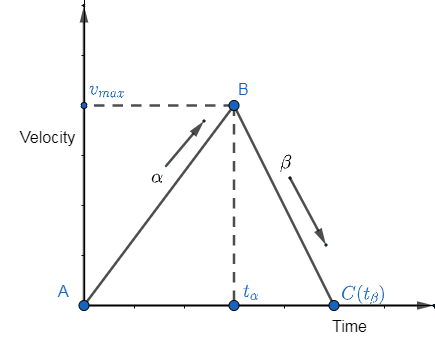
A car accelerates from rest at a constant rate $\alpha$ for some time after which it decelerates at a constant rate $\beta$ to come to rest. If the total time elapsed is t, the maximum velocity acquired by the car is given by
$(a)\text{ }\left( \dfrac{{{\alpha }^{2}}+{{\beta }^{2}}}{\alpha \beta } \right)t$
$\begin{align}
& (b)\text{ }\left( \dfrac{{{\alpha }^{2}}-{{\beta }^{2}}}{\alpha \beta } \right)t \\
& (c)\text{ }\left( \dfrac{\alpha +\beta }{\alpha \beta } \right)t \\
& (d)\text{ }\left( \dfrac{\alpha \beta }{\alpha +\beta } \right)t \\
\end{align}$
Answer
516.1k+ views
Hint: Assuming the maximum velocity, the one relation that relates all the given quantity is $v = u + at$. Using this and dividing the entire time span in two parts, the question can be solved easily.
Complete step by step answer:
Let us consider the car accelerates from rest at a constant rate $\alpha$ for time $t_{\alpha}$ to reach a maximum velocity of $v_{max}$. Therefore, we may write using the equation,
$v = u + at$
where, v is the final velocity, u is the initial velocity, a is the constant acceleration and t is the time taken. In this case,
$v = v_{max}, u = 0, a = \alpha, t = t_{\alpha}$
Therefore, we get,
$v_{max} = 0 + \alpha \times t_{\alpha}$ …(I)
Again, let us consider, the car decelerates from $v_{max}$ to rest at a constant rate of $\beta$ for time $t_{\beta}$. Hence, we have,
$v = 0, u = v_{max}, a = -\beta, t = t_{\beta}$
Therefore, we get,
$0 = v_{max} - \beta \times t_{\beta}$ …(II)
Drawing the car’s journey on a graph, we get

From the above graph, AB is the car's acceleration journey and BC is the decelerated journey.
From the question we know, the entire time taken is t, where $t = t_{\alpha}+t_{\beta}$. Solving Eq. (I) and (II) for $t_{\alpha}$ and $t_{\beta}$, we get,
$t_{\alpha} = \dfrac{v_{max}}{\alpha}$, $t_{\beta} = \dfrac{v_{max}}{\beta}$
Therefore, substituting this value in the below equation, we get
$t = t_{\alpha}+t_{\beta}$
$t = \dfrac{v_{max}}{\alpha} + \dfrac{v_{max}}{\beta}$
Now taking out the common term, we get
$t = v_{max}\left(\dfrac{1}{\alpha} + \dfrac{1}{\beta}\right)$
Taking LCM and solving, we get
$t = v_{max}\left(\dfrac{\alpha+\beta}{\alpha\beta}\right)$
$v_{max} = \left(\dfrac{\alpha\beta}{\alpha+\beta}\right)t$
Therefore, the correct option is D.
Note: If you look closely into the options, you would notice that they are of different dimensions. Hence, without even doing the sum, by performing a simple dimensional analysis, one can say the correct answer is D. It’s a trick that comes handy in a lot of such sums.
Complete step by step answer:
Let us consider the car accelerates from rest at a constant rate $\alpha$ for time $t_{\alpha}$ to reach a maximum velocity of $v_{max}$. Therefore, we may write using the equation,
$v = u + at$
where, v is the final velocity, u is the initial velocity, a is the constant acceleration and t is the time taken. In this case,
$v = v_{max}, u = 0, a = \alpha, t = t_{\alpha}$
Therefore, we get,
$v_{max} = 0 + \alpha \times t_{\alpha}$ …(I)
Again, let us consider, the car decelerates from $v_{max}$ to rest at a constant rate of $\beta$ for time $t_{\beta}$. Hence, we have,
$v = 0, u = v_{max}, a = -\beta, t = t_{\beta}$
Therefore, we get,
$0 = v_{max} - \beta \times t_{\beta}$ …(II)
Drawing the car’s journey on a graph, we get

From the above graph, AB is the car's acceleration journey and BC is the decelerated journey.
From the question we know, the entire time taken is t, where $t = t_{\alpha}+t_{\beta}$. Solving Eq. (I) and (II) for $t_{\alpha}$ and $t_{\beta}$, we get,
$t_{\alpha} = \dfrac{v_{max}}{\alpha}$, $t_{\beta} = \dfrac{v_{max}}{\beta}$
Therefore, substituting this value in the below equation, we get
$t = t_{\alpha}+t_{\beta}$
$t = \dfrac{v_{max}}{\alpha} + \dfrac{v_{max}}{\beta}$
Now taking out the common term, we get
$t = v_{max}\left(\dfrac{1}{\alpha} + \dfrac{1}{\beta}\right)$
Taking LCM and solving, we get
$t = v_{max}\left(\dfrac{\alpha+\beta}{\alpha\beta}\right)$
$v_{max} = \left(\dfrac{\alpha\beta}{\alpha+\beta}\right)t$
Therefore, the correct option is D.
Note: If you look closely into the options, you would notice that they are of different dimensions. Hence, without even doing the sum, by performing a simple dimensional analysis, one can say the correct answer is D. It’s a trick that comes handy in a lot of such sums.
Recently Updated Pages
Why are manures considered better than fertilizers class 11 biology CBSE

Find the coordinates of the midpoint of the line segment class 11 maths CBSE

Distinguish between static friction limiting friction class 11 physics CBSE

The Chairman of the constituent Assembly was A Jawaharlal class 11 social science CBSE

The first National Commission on Labour NCL submitted class 11 social science CBSE

Number of all subshell of n + l 7 is A 4 B 5 C 6 D class 11 chemistry CBSE

Trending doubts
What is meant by exothermic and endothermic reactions class 11 chemistry CBSE

10 examples of friction in our daily life

One Metric ton is equal to kg A 10000 B 1000 C 100 class 11 physics CBSE

1 Quintal is equal to a 110 kg b 10 kg c 100kg d 1000 class 11 physics CBSE

Difference Between Prokaryotic Cells and Eukaryotic Cells

What are Quantum numbers Explain the quantum number class 11 chemistry CBSE




